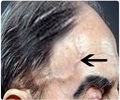Demetrios Spanos was shocked when his doctor discovered a potentially life-threatening weakening affecting his body’s largest blood vessel, the aorta, during a routine physical examination. He had had no symptoms, and was relieved to find out that the weak spot, called an aortic aneurysm, had been caught while it was still small.
For the next few years, a vascular surgeon at the University of Michigan monitored his aortic aneurysm until it reached a dangerous size and required surgery. Aneurysms smaller than 2 inches usually are not too risky. But when they become larger, their potential for rupture is great enough to require surgery. Today, almost a year after his successful surgery at U-M, Spanos credits the early detection with saving his life.Others may soon be like Spanos. As of this year, many newly qualified Medicare patients will be able to receive screening for aneurysms as part of their regular “Welcome to Medicare” physical exam. Men age 65 and older who are current or former smokers, and both men and women who have a family history of aortic aneurysms, are eligible for the free screening – a painless ultrasound test similar to the kind performed on pregnant women.
Routine screenings are important in early detection and treatment of aortic aneurysms, especially because many patients have no symptoms. “The bottom line is to recognize the existence of an aneurysm before something bad happens,” says U-M vascular surgeon James Stanley, M.D., a director of the U-M Cardiovascular Center who operated on Spanos.
“Most of us recognize the recent changes in Medicare law as the beginning of something that is very logical. It’s a real benefit to society, and these early screening programs will save many lives,” he adds.
Approximately 15,000 Americans die each year of ruptured aortic aneurysms, and it is the 10th most common cause of death in the United States. An aortic aneurysm occurs when the walls of the aorta weaken and the artery begins to bulge. If left untreated, the aorta may eventually burst, often causing fatal internal bleeding.
“When that happens, it’s a disaster,” says Stanley, the Handleman Research Professor of Vascular Surgery. “If rupture occurs outside of a hospital setting, there’s at least an 80 percent chance that the patient will die. So the whole idea is to recognize these aneurysms beforehand and treat them before they can rupture.”
Advertisement
Some people inherit genes that make them more prone to aneurysms too. “If anyone in your family tree has an aortic aneurysm, there is a higher chance that you, compared to someone with no family history of an aneurysm, will develop one at some point,” Stanley explains. He recommends that patients with a family history of aneurysms get screened in their early or mid-50s, rather than waiting until age 65. Some insurance programs may cover the screenings, but they are not too expensive for many people to pay out of pocket.
Advertisement
If an abdominal aneurysm is detected and it is large enough to need attention immediately, it can be easily treated. There are two basic types of therapy. One type of treatment, widely used for the past 50 years, is to make an incision in the abdomen and clamp the aorta above and below the aneurysm, and replace it with a Dacron or Teflon tube graft. A newer, so-called endovascular method is minimally invasive and involves eliminating blood flow into the aneurysm by re-channeling the blood from above the aneurysm to below it. This method uses a tube graft that is threaded into the aorta from an artery in the groin, the same artery used for heart catheterizations. Both types of therapy have at least a 95 percent chance of success.
Aneurysms can be repaired by several different kinds of doctors, including vascular surgeons, heart surgeons, and interventional radiologists. The U-M Cardiovascular Center is unique because all of these doctors work together to determine the best course of action for each patient.
Source-Newswise
SRM






